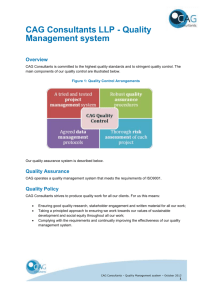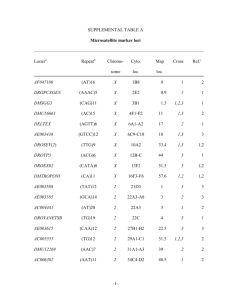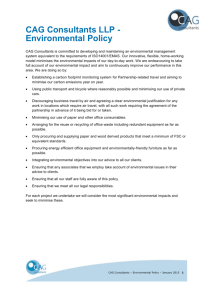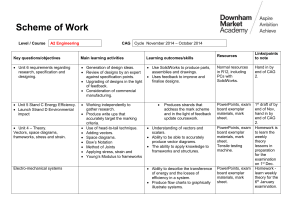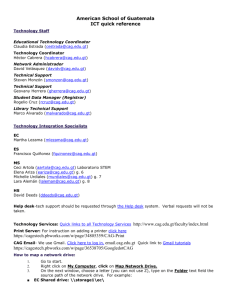Libby Community Advisory Group Meeting Summary January 11, 2007 Introductions
advertisement
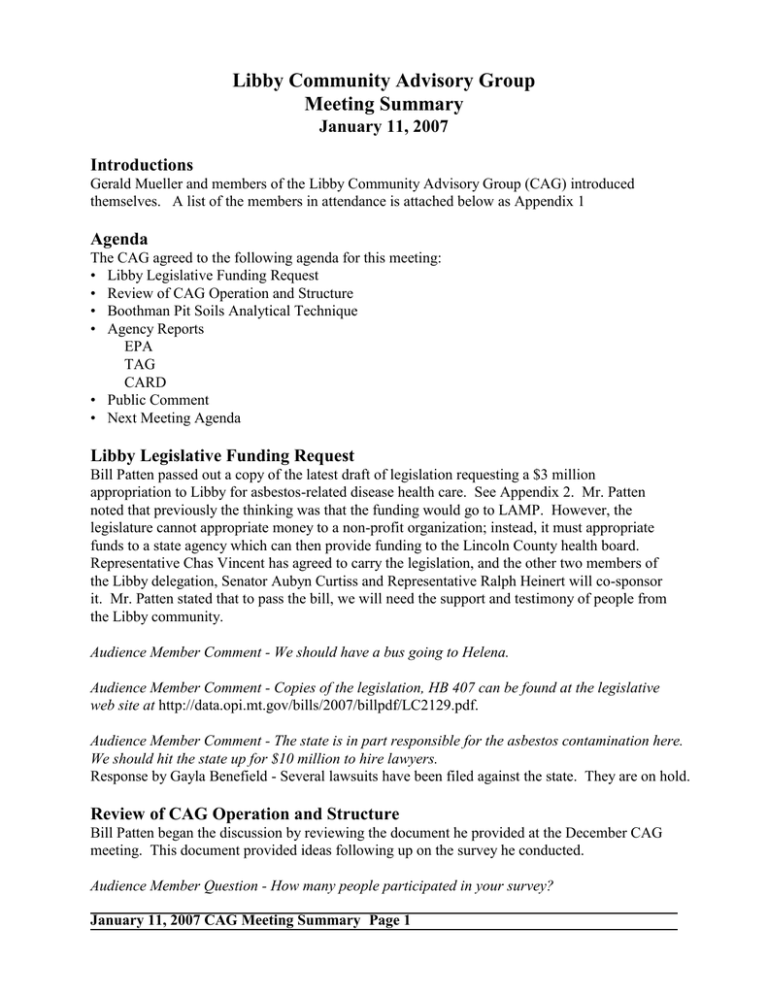
Libby Community Advisory Group
Meeting Summary
January 11, 2007
Introductions
Gerald Mueller and members of the Libby Community Advisory Group (CAG) introduced
themselves. A list of the members in attendance is attached below as Appendix 1
Agenda
The CAG agreed to the following agenda for this meeting:
• Libby Legislative Funding Request
• Review of CAG Operation and Structure
• Boothman Pit Soils Analytical Technique
• Agency Reports
EPA
TAG
CARD
• Public Comment
• Next Meeting Agenda
Libby Legislative Funding Request
Bill Patten passed out a copy of the latest draft of legislation requesting a $3 million
appropriation to Libby for asbestos-related disease health care. See Appendix 2. Mr. Patten
noted that previously the thinking was that the funding would go to LAMP. However, the
legislature cannot appropriate money to a non-profit organization; instead, it must appropriate
funds to a state agency which can then provide funding to the Lincoln County health board.
Representative Chas Vincent has agreed to carry the legislation, and the other two members of
the Libby delegation, Senator Aubyn Curtiss and Representative Ralph Heinert will co-sponsor
it. Mr. Patten stated that to pass the bill, we will need the support and testimony of people from
the Libby community.
Audience Member Comment - We should have a bus going to Helena.
Audience Member Comment - Copies of the legislation, HB 407 can be found at the legislative
web site at http://data.opi.mt.gov/bills/2007/billpdf/LC2129.pdf.
Audience Member Comment - The state is in part responsible for the asbestos contamination here.
We should hit the state up for $10 million to hire lawyers.
Response by Gayla Benefield - Several lawsuits have been filed against the state. They are on hold.
Review of CAG Operation and Structure
Bill Patten began the discussion by reviewing the document he provided at the December CAG
meeting. This document provided ideas following up on the survey he conducted.
Audience Member Question - How many people participated in your survey?
January 11, 2007 CAG Meeting Summary Page 1
Answer by Bill Patten - I surveyed 27 individuals. My survey was not meant to have scientific
validity as representative of the Libby community. I conducted it in response to the homework
assignment given at the October CAG meeting to talk with interests in the community such as
business owners and realtors to learn why they are not attending CAG meetings and to invite
them back.
Audience Member Comment - This survey should be expanded to take in the entire Libby community.
CAG Member Comment - When the CAG was first formed, some of us identified and sought CAG
representation from the different segments of our community. We should go public with a notice
that we are reorganizing and are seeking additional members.
Audience Member Comment - The CAG is the most important group in town.
CAG Member Comment - CAG members should represent some segment of the community rather
than just themselves as individuals.
CAG Member Comment - In addition to group or organizational representatives, we also need
individuals so we can get both sides of the story. Advisory groups are congressionally mandated
to get the public involved. CAG membership should be open to anyone who wants to help out.
Audience Member Comment - Seven years ago, when I first began attending CAG meetings, I did
so in the audience. The CAG then had about 30 members. Some participated to oppose a
Superfund designation. About half of the CAG members dropped out when the Superfund
designation issue did not go away. I later took a seat on the CAG because I didn’t feel anyone
was representing me.
CAG Member Comment - Perhaps we should have a mix of CAG members, some of whom
represent community groups and a few who serve as individuals.
Audience Member Question - What specifications are in the Superfund law for community
advisory groups?
Answer by Ted Linnert - EPA has written guidelines for community advisory groups, but they
are flexible. An advisory group can be whatever the community wants it to be.
Audience Member Comment - My concern is that the true impacted parties should be represented
on the CAG. These are the victims of asbestos-related disease and the homeowners. Some 1,400
properties face cleanups. We have formed a homeowners association to involve these property
owners. The first meeting was attended by 35 homeowners. This meeting was not just a bitch
session. People were interested in what happens when a cleanup occurs. We talked about
actions people can take to protect themselves, such as by vacuuming.
Audience Member Comment - We prepared an application to EPA for a $50 thousand
environmental justice grant to support the homeowners association. We finished a draft on a
Thursday, and it was due on the following Monday. However, we opted not to submit it because
we were advised that we probably would have to be a 501(c)(3) non-profit organization. We may
January 11, 2007 CAG Meeting Summary Page 2
submit the grant next year, but we will need community support.
CAG Member Comment - What happens to our homes directly affects the community. We need
to involve realtors and the business community on the CAG in addition to homeowners.
CAG Member Comment - Everyone impacted should be represented. We should continue to have
representation from EPA, the hospital, CARD, TAG, and the Operation and Maintenance
Working Group.
Audience Member Question - Is EPA generally represented on advisory groups?
Answer by Ted Linnert - EPA generally participates, but as a non-voting member.
Audience Member Comment - The CAG is important because it provides a venue for EPA to get
a consistent message to the community.
Response by Paul Peronard - EPA does attend many community group meetings and will continue
to do so. We try to provide a consistent message to all of them. However, people have different
interests. They can hear the same statements but interpret them to have different meanings,
depending on their interests.
Audience Member Comment - I spent four years on the CARD board of directors, and then I took a
year off. Many community organizations are looking for our time. People only have so much time
to serve in community organizations, and only some people are willing to give it. The CAG is an
important organization to this community.
CAG Member Comment - We used to have elected officials on the CAG. Since the city got in bed
with W.R. Grace, EPA is not allowed to attend city meetings. Community members are precluded
to ask questions at county commission meetings. Our local officials were elected to represent the
community. We should send a letter to the cities of Libby and Troy and the county asking them to
have a representative participate on the CAG.
CAG Member Question - Is there a legal reason that county commissioners are not on the CAG?
Answer by Paul Peronard - EPA is not allowed to pay local officials to participate in groups such as
the TAG. We pay for the CAG facilitator and for meeting room and sound arrangements. CAG
members are not paid, so local officials can be members.
Audience Member Comment - There was a point when the county was considering legal action
against W.R. Grace and was advised by the Donovan Group that it should not be on the CAG.
CAG Member Comment - One of the reasons that our local officials stopped participating on the
CAG is because they were repeatedly attacked.
CAG Member Comment – No one likes to be attacked. We need to be careful about the language
we use. We can challenge ideas and seek information without attacking people.
CAG Member Comment - In our first three years, there was a lot of emotion at our meetings. But
people needed a way to express the anger they were feeling. This emotion has largely dissipated.
January 11, 2007 CAG Meeting Summary Page 3
We have achieved a lot since then. For example, we have gotten medical care and psycho-social
services.
CAG Member Comment - Since I have been coming to CAG meetings over the last few years,
communication at CAG meetings has changed for the better. Detailed information is getting out. I
like the idea of an environmental justice grant to support the homeowners association.
CAG Member Comment - Our elected officials are also concerned about the negative publicity
Libby has gotten because of the Superfund cleanup. At a recent county commission meeting, the
story was told about a local woman flying on a commercial airline. When the woman in the seat
next to her learned she was from Libby, the non-Libby resident demanded to change her seat.
Audience Member Comment - At a recent Nordic Fest, someone didn’t want to bring their horses
here because of concern about the asbestos contamination.
CAG Member Comment - One of the challenges we face at the hospital in recruiting medical staff is
concern about the contamination.
CAG Member Comment - About once a month, a negative story about Libby hits main street, but
people continue to move here and properties are selling. The most recent edition of the Western
News reports that in 2006, 47 building permits were issued for $3.2 million in construction. Some
56 new septic systems were installed in Libby and 47 in Troy. Flathead Electric had 38 new
installations in the Libby area along with 120 rebuilds and upgrades. Last year 126 homes sold in
Libby and 41 in Troy. The sale prices for Libby homes ranged from $47 thousand to $800
thousand. Home prices in Troy ranged from $59,900 to $2.9 million. According to the mayor, few
houses are available at $100 thousand.
CAG Member Comment - In addition to addressing issues such as the property cleanups, we need
to focus on how we move into the future.
CAG Action - The CAG agreed to contact the Cities of Libby and Troy and the Lincoln County
Commissioners and request that these governments have a member representing them on the
CAG. Bill Patten and Tanis Hernandez agreed to draft and send a letter on behalf of the CAG
making the invitation to the cities and county and requesting a response. The letter will also
explain that the CAG is considering reformulating itself. Bill Patten was authorized to sign the
letter on behalf of the CAG. Current CAG members also agreed to review the original list of
CAG members and come to the February CAG meeting prepared to identify the specific
organizations to invite to designate representatives to serve as CAG members. Mr. Mueller was
asked to send to the CAG the original roster of CAG members.
The CAG then developed a list of topics that it will address in its reformulation discussion. These
topics will be discussed after the new members have joined the CAG. The list included:
• Organization name;
• Number of members;
• Membership requirements and responsibilities;
• Purpose/mission statement;
January 11, 2007 CAG Meeting Summary Page 4
•
•
•
•
•
•
Ground rules;
Agenda setting;
Role of facilitator, if any;
Designation of a chair person;
CAG meeting room; and
Relationship to other community groups.
Bill Patten and LeRoy Thom also volunteered to visit the local newspapers and radio stations to
seek publicity that the CAG is reformulating and considering the preceding list of issues.
Boothman Pit Soils Analytical Technique
Paul Peronard discussed the available instruments used to analyze soil samples. One is the phase
contrast microscope. This instrument has the lowest magnification and may not be useful in
distinguishing between types of fibers, such as asbestos and cellulose. It is not used to analyze
Libby soil samples. Another is the polarized light microscope (PLM). This instrument can magnify
up to 2,000X, but is generally used in analyzing soil samples in the 400 - 800X magnification range.
The third instrument is the transmission electron microscope, (TEM) which can magnify up to
40,000X, and is generally used at magnifications around 20,000X. The final instrument is the
scanning electron microscope (SEM), which can also magnify up to 20,000X. Use of this
instrument is generally limited to research; it is not used for commercial analyses. The United
States Geological Service has used SEM in research on Libby amphibole. One might expect that,
because of its higher magnification capability, TEM would be the best instrument for Libby soil
analysis. This is not correct, however, because of TEM’s small field of view. Asbestos in soil
samples is generally not evenly distributed, but occurs in clumps. Using TEM may miss a
significant amount of asbestos fibers, resulting in what is known as a false negative reading, i.e.,
asbestos is present but not detected. TEM is routinely used to analyze ambient air samples, rather
than solid media samples. For solid sample analysis, PLM is used because it can view a larger
sample size.
Two types of PLM analysis exist. The difference between the two relates to sample preparation
rather than the instrument itself. In polarized light microscopy, visual estimation (PLM-VE), the
sample is ground and homogenized, which eliminates the clumping issue. The analytical sensitivity
of the standard PLM analysis, known as NIOSH 9002, is a 1% asbestos concentration. PLM-VE is
sensitive down to a concentration of 0.2% asbestos. This means that the sensitivity limits of both
PLM techniques are higher than the concentrations of concern; thus a non-detect sample may
contain asbestos in amount with negative health consequences. EPA will address this issue in the
risk analysis.
In the Boothman Pit analyses, and the analyses of all backfill (i.e. clean) soils, EPA uses the
following procedure:
• First, all loads of backfill are visually inspected for vermiculite sources.
• Second, every 3,000 cubic yards (yd3) a sample is taken for a PLM-VE analysis, which is
conducted in Denver. These samples are ground, homogenized and sent out to a commercial
laboratory.
• Third, when quick turn-around is needed, the NIOSH 9002 PLM technique is used because it can
be done locally.
January 11, 2007 CAG Meeting Summary Page 5
• Fourth, one of five personnel involved in the digging and transportation of backfill material wear
personal ambient air samplers, which are analyzed using the PLM and TEM instruments.
• Fifth, at the site in which backfill is place, activity based sampling occurs. In this sampling,
ambient air monitoring is conducted of sample activities expected on the site, such as raking and
crawling in the dirt. These samples are analyzed using TEM.
Using this procedure, EPA can be 100% confident that backfill will not be a source of asbestos
contamination. Backfill will have an asbestos concentration at least four orders of magnitude less
than the contaminated soil that is being removed and replaced, even when the contaminated soil has
a non-detect asbestos concentration reading.
Audience Member Question - Do you use activity sampling after sod is laid?
Answer - It depends on the site.
Audience Member Question - Is the Boothman pit licensed by the state?
Answer - Yes. Removing 10,000 yd3 triggers the state permitting requirement.
Audience Member Question - When you open a pit to provide backfill, do you analyze the material
that is scraped off and set aside?
Answer - No. You raise a good point, and we should analyze this material.
Audience Member Comment - Soils adjacent to the disturbed area for the backfill pit should also be
analyzed.
Audience Member Comment - I am relieved that EPA is conducting the activity sampling.
Audience Member Question - Does the grinding affect sample morphology?
Answer - Yes. PLM-VE cannot be used to determine asbestos fiber size distributions. TEM is used
in ambient air sampling and to determine fiber size distributions.
Audience Member Comment - Chris Weis told me that the resolution limit for PLM is 0.25 microns.
Response - PLM is used for solid matrix samples, not for individual asbestos fiber analysis.
Audience Member Question - Do you keep track of moisture content when conducting activity
based sampling?
Answer - No, but we do not do this sampling in the rain. The activity sampling is conducted
under typical Libby summer day conditions. Typical and worst case conditions will be addressed
in the risk analysis.
TAG Report
Gayla Benefield reported on behalf of the TAG. The TAG board of directors has elected new
officers. Mike Noble is the new chairman and Kathy Sullivan is the Treasurer. The TAG
Technical Advisor, Gerry Henningsen, and Gayla Benefield have been invited to attend an EPA
meeting at Research Triangle Park in North Carolina to discuss Libby risk studies. Scientists
from across the country will be attending.
January 11, 2007 CAG Meeting Summary Page 6
EPA Report
Mike Cirian reported for EPA on the following topics.
Training - Next month EPA will conduct free asbestos-related training for the public and contractors.
With some exceptions, attendance will be on a first-come-first serve basis. The exceptions are slots
that will be reserved for fire fighters and other city personnel. Four classes will be offered, with
class size limited to 20 students per class. The classes will be: a 40-hour hazardous waste operator
class, a 40-hours asbestos contractor/supervisor class, an 8-hour hazardous waste operator refresher
class, and an 8-hour asbestos contractor/supervisor class refresher class.
Ambient Air Sampling - Nine rounds of ambient air sampling have been conducted, and a tenth
round is beginning. At the last CAG meeting, EPA proposed reporting the results of this sampling
quarterly. Public comments on the frequency and format of the reporting are still being taken.
Environmental Resource Specialist Position - Two incidents involving this position occurred
since the last CAG meeting. Both were house fires. The first had a fatality. EPA and the fire
department learned from the first fire, and response to the second was better from an asbestos
contamination perspective.
Audience Member Question - Would you please discuss the detection of asbestos in the ambient
sampling in Helena?
Answer - EPA is conducting ambient air sampling in Helena and Eureka to provide
control/background sampling to compare to the Libby air sampling. One Helena sample
appeared to have six Libby amphibole detections, and the highest asbestos background
concentrations measured to date. We are rechecking the analyses. Assuming the Libby
amphibole concentration readings to be correct, we are trying to understand what the source
might be. We are characterizing the areas surrounding the Helena monitor in search of a possible
source or explanation.
CARD Clinic Report
Tanis Hernandez reported on behalf of CARD. She stated that CARD will be conducting a series
of meetings on the third Tuesday of the next three months at 7:00 p.m. in the Ponderosa Room of
Libby City Hall. The CARD Research Series: Guiding Asbestos Research Towards Treatment.
On February 20, CARD will present what asbestos research is all about, the role of the Libby
community and the role of CARD. On March 20, the topic will be understanding how a
successful research center is created and the importance of coordinated research. On April 17,
CARD will present on past, current, and future research projects and how they can lead to
improved treatment.
Public Comment
Audience Member Question - To ensure that we can have confidence in the cleanups of our
homes, will EPA have an independent company test the validity of the cleanups?
Answer by Paul Peronard - Any firm that EPA pays would probably not be viewed as independent.
We do not plan to have a company independent of EPA check the cleanups. EPA will be going
back to some of the homes cleaned to resample for contamination. We also routinely send blind
samples to more than one commercial laboratory to check the validity of the sampling results.
January 11, 2007 CAG Meeting Summary Page 7
Next Meeting Agenda Topics
The CAG agreed to the following topics for its next meeting:
• An update on the status of the funding legislation.
• A discussion of the community groups that should be invited to send representatives to
participate on the CAG.
• Follow-up on the letter to the Cities of Libby and Troy and Lincoln County requesting their
participation on the CAG.
• Agency reports.
Next Meeting
The next meeting is scheduled for 7:00 to 9:00 p.m. on February 8, 2007 in the Ponderosa Room
of Libby City Hall.
Appendix 1
CAG Member & Guest Attendance List
January 11, 2007
Members
DC Orr
Bill Patten
Paul Peronard
Ted Linnert
Mike Cirian
LeRoy Thom
Gayla Benefield
Eileen Carney
Group/Organization Represented
City of Libby
St. John’s Lutheran Hospital
EPA
EPA
EPA - Libby
Former Grace Employee
TAG - LCAVRO
Board of Respiratory Therapists
Visitor
Gerry Henningsen
TAG Technical Advisor
Appendix 2
Unofficial Draft Copy
As of: January 5, 2007 (9:55am)
LC2129
Bill No.
INTRODUCED BY
BY Request of the
A bill for an Act entitled: "An act allowing funding in the asbestos disease
account to be used by the department of public health and human services for
grants to the Lincoln County health board asbestos-related disease programs,
including services that supplement health care plans and provide screening
services; appropriating $3 million for the programs; providing a contingent
termination date; and providing an effective date."
WHEREAS, ongoing litigation with W.R. Grace & Company and delays at the
federal level in approving asbestos-related legislation put future funding for
important programs that assist those exposed to asbestos in jeopardy; and
WHEREAS, programs providing annual screening benefits to individuals
exposed to asbestos and supplementing the health care needs of individuals
diagnosed with asbestos-related diseases have limited funding.
BE IT ENACTED BY THE LEGISLATURE OF THE STATE OF MONTANA:
Section 1.
Section 50-1-111, MCA, is amended to read:
“50-1-111.
Asbestos disease account.
There is an asbestos disease
account in the state special revenue fund to be used by the department for
grants to the Lincoln County health board to be used for the following
purposes:
(1) providing case management services for asbestos patients;
(2) maintaining and overseeing a working network of Lincoln County
health care and social service providers;
(3) providing direct services to individuals who have a positive result
as determined by a qualified physician for asbestos-related diseases;.
Services include, but are not limited to, programs that assist in the
following:
(a) paying certain costs associated with annual screenings for asbestosrelated disease; and
(b) assisting individuals who have medical needs that are not fully
covered by a governmental, group, or individual healthcare plan;
(4) evaluating the programs for effectiveness and quality; and
(5) pursuing both short-term and permanent funding for health care and
social service needs of asbestos patients.”
(Internal References to 50-1-111: None.)
NEW SECTION.
Section 2. Fund transfer –- appropriation. There is
transferred $3 million from the general fund to the asbestos disease account
provided for in 50-1-111.
The money in the account is appropriated to the
department of public health and human services to be used for grants to the
Lincoln County health board for the purposes stated in 50-1-111.
NEW SECTION.
Section 3. Contingent termination. (1) The asbestos
diseases account provided for in 50-1-111 terminates n the date that the
director of the department of public health and human services certifies to
the governor that a permanent source of funding for medical and psychosocial
care for Lincoln County asbestos patients is established through resolution of
the ongoing litigation or federal program.
(2) The governor shall transmit a copy of the certification to the code
commissioner.
(3) Any excess funds remaining upon the termination of the account must
be transferred to the general fund.
NEW SECTION.
Section 4.
(standard) Effective date. [This act] is
effective July 1, 2007.
- END {Name:
Sonja E. Lee
Title:
Research Analyst
Agency:
LSD LEPO
Phone:
406-444-3078
E-Mail:
sonjalee@mt.gov}
